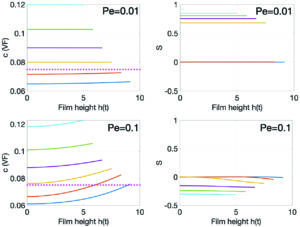For many products such as paints, inks, or cosmetics, the evaporation of water or another solvent is one of the key stages of their application. It not only serves as the medium in which all the other formulation ingredients are dispersed, but also plays a role in what the final structure of the dried product will be and therefore determines its properties. As the product dries, the air/water interface can trap some of the particles resulting in an enrichment of that ingredient at the top of the dried surface, or hydrodynamic phenomena can result in convection flows that recirculate the ingredients to obtain a more homogenous dried product. How these phenomena affect the different ingredients is also influenced by their shape, i.e. whether they are spherical, rod-like, cube-like, or others. In the case of particles with a preferential direction, such as rods, they might have a strong tendency to align parallel to the air/water interface to minimize their energy.
In this publication, the authors simulate the drying process of a dispersion containing rod-like particles to obtain insights on the effect of different parameters on their final orientation in the dried film. They investigate how and when the transitions in orientation take place, providing useful guidance for the optimization of systems which involve rod-shaped particle such as gold or zinc oxide nanorods.
Comments from the authors:
- Above a certain volume fraction, rod-shaped particles spontaneously align in one direction, reducing the total excluded volume of the system. This is called the isotropic-nematic phase transition, first predicted by Onsager.
- During solvent evaporation of a thin film, the concentration field become inhomogeneous in the direction vertical to the substrate: particles are concentrated mostly at the liquid-air surface and phase transition starts from the top surface.
- The structural arrangements of rod-shaped particles are closely related to the dynamics of evaporation, particle aggregation, and the phase transition during the evaporation of a thin film.
- However, as for the evaporation-induced deposition patterns, few studies have been devoted to the dynamic aspects of the phase transition of rodlike particles in a drying film.
- We obtain spatiotemporal evolution of phase transition processes of rod-shaped particles in a vertically drying thin film.
- It is shown that indeed the evaporation dynamics can alter the orientational configuration in equilibrium to meta-stable states.
- This alternation from a stable state is mainly due to the anisotropic kinetics of particle diffusion coupled with the dynamics of solvent evaporation.
Citation to the paper: Evaporation-induced alignment of nanorods in a thin film, Multi-component colloidal gels: interplay between structure and mechanical, Narina Jung, Byung Mook Weon, and Masao Doi. : Soft Matter, 2020, 16, 4767. DOI: 10.1039/d0sm00482k.
To read the full article click here!
About the web writer
Dr Nacho Martin-Fabiani (@FabianiNacho) is a UKRI Future Leaders Fellow at the Department of Materials, Loughborough University, UK.











